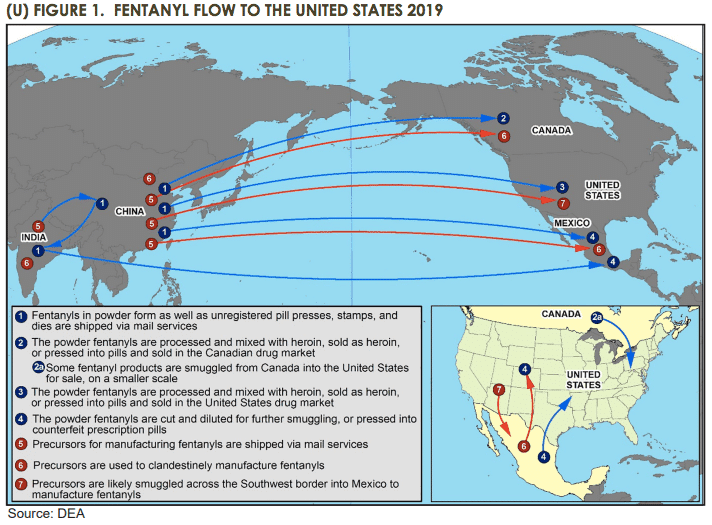America has been struggling with a widespread opioid crisis for years, and fentanyl is one of the most problematic drugs involved. But given China’s crucial role in fentanyl supply chains, dealing with the crisis requires dealing with Beijing. The breakdown in cooperation is emblematic of the broader rift between the two superpowers.
Fentanyl is a synthetic opioid estimated to be at least 80 times as potent as morphine, and hundreds of times more potent than heroin. It’s deadly, and along with meth, it’s dominating illegal drug markets worldwide.
America’s Fentanyl Crisis
In North America in particular, fentanyl has exacerbated the opioid crisis. In March 2022, 12-month drug fatality figures reached the highest recorded level ever, at over 110,300 deaths. In 2019, overdose deaths numbered about 71,000. Two-thirds of last year’s deaths involved synthetic opioids like fentanyl. Fentanyl is often cut into other drugs like heroin and cocaine, putting people at higher risk of accidental overdose.
Secretary of State Antony J Blinken commented on the situation earlier this month. After stating that drug overdose had become the number one killer of Americans aged 18-49, Blinken called the crisis “a problem that no country can solve alone.”
These remarks were made at the first virtual meeting of a global coalition of nations America has assembled with the aim of mitigating the problem of synthetic drugs. China was invited to take part and join the group, but has thus far refused.
But it wasn’t always so. Back in 2019, it seemed China and the US were primed to enter into a new era of cooperation to stem the flow of fentanyl between the two countries.
In 2019, China banned all variants of fentanyl, in a move that fulfilled a promise made by Xi Jinping to then-President Donald Trump. China remains the only country in the world to have comprehensively scheduled fentanyl in all its forms – in the US fentanyl analogues are only restricted on a temporary basis, with classification set to expire at the end of 2024.
In the period before and immediately after Beijing’s ban, exports of fentanyl precursor chemicals to the US plummeted, and cooperation between law enforcement on both sides did the opposite. In November of 2019, a Hebei court convicted nine individuals for trafficking fentanyl into the US – collaboration that would be impossible today.

So what happened?
Trouble started in that same year when it became clear to the CCP that the Trump administration wouldn’t lift trade tariffs it had imposed in 2018. Cooperation slowed to a crawl.
More recently, following then-Speaker Nancy Pelosi’s visit to Taiwan last August, Beijing pulled the plug on all dialogue. During his visit to Beijing last month, Blinken told reporters Beijing had agreed to “explore setting up a working group or joint effort” to tackle the drug issue once more.
But just days later, the US announced four Chinese companies would be indicted, accused of trafficking precursor chemicals used by Mexican cartels to manufacture fentanyl sold in the US. China lashed back, criticising the US for trying to ‘shift blame’ away from itself, and the partnership sunk back into its impasse.
America’s timing, with the arrests and indictments of Chinese entities occurring while Blinken was in Beijing trying to restart dialogue, indicate a fundamental discrepancy in their understanding of the issue.
For the US, the opioid crisis is a humanitarian problem, the negotiation of which sits above geopolitics. Not so for China. As the Global Times – a CCP mouthpiece – writes, explicitly, “With sanctions still in place, the normalization of anti-drug collaboration is out of the question.”
Follow Maddie’s journalism on Twitter.
Sign Up To Our Free Newsletter